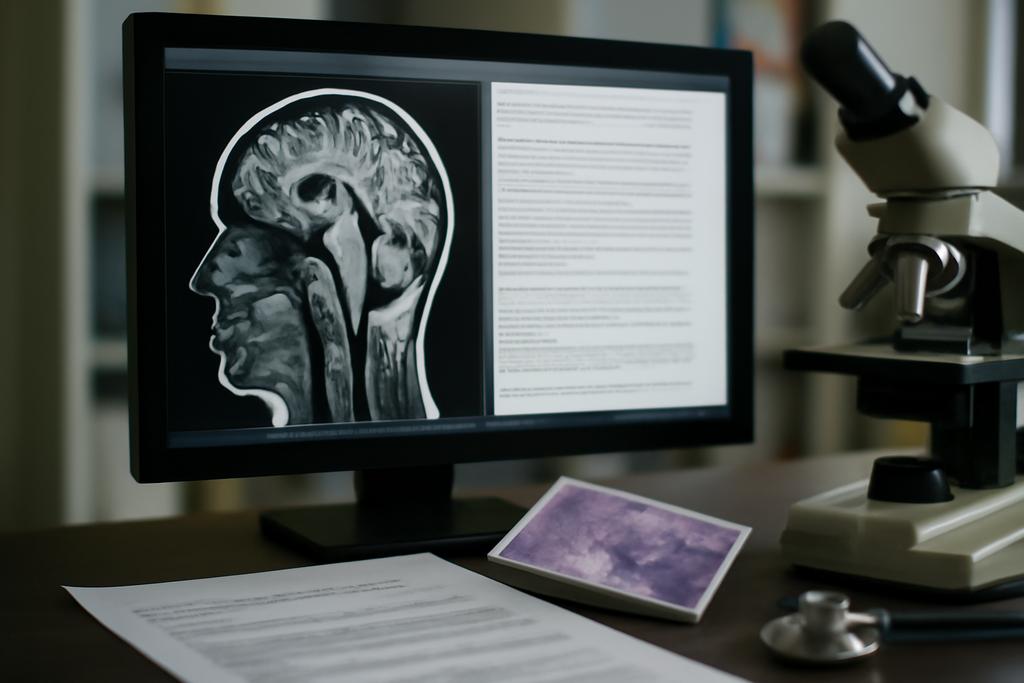The future of medical AI isn’t about a single specialty model that knows a little radiology, a bit of pathology, and some dermatology. It’s about a generalist, a model that can read a radiology image, a pathology slide, and the doctor’s notes, all in one coherent whisper of understanding. A team of researchers from Emory University and the Georgia Institute of Technology has taken a bold step toward that future with a system they call MMKD-CLIP. It doesn’t train on billions of random photos and captions. Instead, it learns by listening to nine expert peers, each a specialist in a different corner of biomedicine. The result is a single, generalist vision–language model that can navigate many imaging modalities and clinical tasks without being retrained from scratch for every new domain. The study is led by Shansong Wang at Emory University, with Xiaofeng Yang of Emory and Georgia Tech as a key guiding voice behind the project.
In medicine, the gap between “one model fits all” and “many models for many jobs” has always shone brightest when you look at data. Biomedical images come in at least two languages: pictures (MRI, CT, X-ray, ultrasound) and words (reports, captions, patient notes). The standard CLIP idea—pairing images with text to learn a shared space—tellows a model to recognize concepts without explicit labeling. But the biomedical world is messy: data are scattered across hospitals, modalities differ, labeling is costly, and the same disease looks different across channels. MMKD-CLIP tackles this head-on by creating a generalist backbone through a clever kind of collaboration—knowledge distillation from multiple specialized CLIP models into one student model. It’s like assembling a chorus of experts whose combined wisdom guides a single learner toward a more robust, flexible understanding of medicine.
Unifying medicine’s many visuals in one model
To appreciate MMKD-CLIP, imagine a medical AI that can think across MRI, CT, ultrasound, endoscopy, pathology slides, and even fundus photography—while also grounding its visual sense with textual context from radiology reports, pathology notes, and clinical narratives. That’s the pitch, and the team delivers it with a two-stage training plan. First, MMKD-CLIP is pretrained on 2.9 million biomedical image–text pairs drawn from the PubMed Central Open Access (PMC‑OA) collection, spanning 26 imaging modalities. This is a careful, curated pretraining step designed to sew together many kinds of medical visuals with their descriptive language. Then comes the second stage: offline knowledge distillation from nine teacher CLIP models, each already trained on millions of biomedical image–text pairs. The student model absorbs their wisdom not by copying raw data, but by learning from the teachers’ feature representations. The goal is a compact, generalist model that benefits from diverse specialist insights without needing billions of raw pairs itself.
The technical strategy is precise but the intuition is human-friendly: let many seasoned experts each explain a facet of medicine, then distill that collective know-how into a single, more capable apprentice. The teaching lineup includes renowned domain models such as MedCLIP, PubMedCLIP, QuiltNet, and BiomedCLIP, among others. The MMKD-CLIP team doesn’t rely on unfiltered flood data; instead, they build a distillation corpus of 19.2 million teacher feature quadruplets—image, text, and each teacher’s corresponding image and text features—so the student can learn to align multimodal signals across modalities without re-extracting from raw data every time. It’s a data-efficient way to fuse knowledge across disciplines.
How multi-teacher distillation actually works
The distillation process hinges on selectivity and collaboration. Per image–text pair, MMKD-CLIP looks at nine different biomedical CLIP teachers but doesn’t trust them blindly. It uses a trust-and-verify step: for a given pair, it runs the pair through multiple teachers in a zero-shot setup and checks whether the teacher’s prediction for the correct class surpasses a 0.90 confidence threshold. If a teacher passes that bar, its visual and textual embeddings for that pair are included in the distillation quadruplet. If not, that teacher’s signal for that instance is ignored. The idea is simple and powerful: rely on the most competent voices for each example, while letting the ensemble of voices cover a broad spectrum of modalities and domain knowledge.
Once the trustworthy teachers are selected, their outputs are projected into a common 512-dimensional space via CLIP-specific projection encoders. All the projected features are then funneled through a shared dual‑stream autoencoder that learns a joint representation across all teachers and modalities. There’s a reconstruction step too: decoders try to reconstruct each teacher’s features from the shared space, ensuring the student preserves the unique stylistic flavor of each teacher while still reaping the benefits of cross-teacher harmonization. Importantly, the training avoids forcing all teachers into one latent space with a single objective; instead, it respects the teachers’ native distributions and uses the autoencoder to stitch them together into a robust, multimodal topography.
All of this is wrapped into a single distillation objective that combines three components: the standard CLIP loss (to keep image–text alignment intact), a feature distillation loss (to pull the student’s embeddings toward the teachers’ embeddings), and an interactive contrastive learning loss (to encourage mutual information flow between student and teacher representations). The researchers tune these terms with carefully chosen weights, creating a synergy that preserves the strengths of each teacher while enabling new generalization capabilities in the student. The result is a single model whose space is shaped by nine different biomedical experts, each contributing a distinct perspective on what counts as a meaningful medical concept across modalities.
What the numbers reveal about a biomedical generalist
If you want a number-driven verdict, MMKD-CLIP’s performance across 58 benchmarking datasets offers a striking one: the student consistently outperforms all nine teacher models across six downstream task types—zero-shot classification, linear probing, cross-modal retrieval, visual question answering (VQA), survival prediction, and supervised cancer diagnosis—while showing remarkable robustness across nine imaging modalities and more than 10 million images. It’s not just a few cherry-picked wins; it’s a broad, cross-domain boost that hints at a genuinely generalizable biomedical foundation model. In zero-shot classification across nine modalities, MMKD-CLIP tops the field in MRI, CT, fundus, OCT, endoscopy, and X‑ray, with MRI and several other modalities showing statistically significant gains over the next-best models. In ultrasound and dermatology, where specialization sometimes dominated, MMKD-CLIP still lands in the top ranks, underscoring the strength of its cross-modality training.
Beyond raw accuracy, the model’s consistency across datasets—its ability not to overfit to a single source—speaks to practical value in real clinics where devices and patient populations vary. In linear probing, where the model’s capacity is tested under limited labeled data, MMKD-CLIP achieves substantial AUC advantages even with as little as 1% of the data in certain modalities. The authors quantify a macro-AUC edge over top baselines in several modalities, which matters in settings where labeling resources are scarce. In cross-modal retrieval, MMKD-CLIP shows meaningful improvements in both text-to-image and image-to-text directions across distinct datasets, including MedTrinity‑25M and BookSet—evidence that its multimodal alignment remains stable in both noisy, real-world clinical contexts and cleaner, curated datasets. In VQA benchmarks, it delivers the highest accuracy across SLAKE and VQA-RAD, demonstrating proficiency in both open-ended reasoning and closed-form answers. Survival prediction across 12 cancer types further showcases the model’s practical reach, combining image patches with clinical notes to produce risk stratifications that hold up across multiple datasets and time horizons. In supervised cancer classification tasks, the model not only matches but often exceeds specialist baselines across the BRACS, TCGA-NSCLC, and Camelyon16 datasets. The take-home: a well-crafted, multi-teacher distillation pipeline can yield a generalist model that is both accurate and broadly applicable, even when data are heterogeneous and labeling is patchy.
Why this matters now and what it could unlock
The appeal of MMKD-CLIP isn’t only its performance figures; it’s the practical implications for how medicine could be practiced and studied. A single, robust foundation model that can understand a wide array of imaging modalities and textual sources could dramatically reduce the need to deploy and maintain dozens of domain-specific models. In clinics with limited resources or in research environments that must integrate data from multiple hospitals, a generalist model could accelerate the velocity of discovery and decision support. It could enable rapid evaluation of new imaging modalities as they appear, since new domain experts could be added to the teacher pool and the student could absorb their wisdom without a full rebuild. In other words, MMKD-CLIP sketches a pathway toward a more adaptable, data-efficient, and interoperable biomedical AI ecosystem.
There’s also a deeper cultural take here. Medicine thrives on synthesis—radiology images, tissue slides, and clinical narratives each telling part of a patient’s story. The MMKD-CLIP approach mirrors that integrative practice: it respects the value of each specialized voice while weaving them into a shared compass. If successful at scale, such a generalist foundation could become a backbone for clinical decision support, medical literature navigation, and even patient-facing tools that translate complex imagery and notes into accessible explanations. The study’s emphasis on open extensibility—an extensible distillation framework designed to incorporate future biomedical CLIP models—addresses a perennial constraint in biomedical AI: the field moves quickly, and the data landscape is perpetually evolving. The MMKD-CLIP team has built in a mechanism to stay current, a practical roadmap for long-term progress.
Institutional anchors behind the work include Emory University’s Department of Radiation Oncology (Winship Cancer Institute) and the Georgia Institute of Technology’s Electrical and Computer Engineering, Biomedical Engineering, and Computer Science groups. The lead author is Shansong Wang, with Xiaofeng Yang serving as the corresponding author and a central figure coordinating the collaboration across Emory and Tech. This is a milestone born of cross-institutional dialogue between clinical medicine, engineering, and computer science, a reminder that breakthroughs in biomedical AI often come from teams that span halls and disciplines rather than a single lab bench.
What this means for the road ahead
MMKD-CLIP isn’t the final destination; it’s a proof of concept with a concrete design that invites replication, extension, and practical deployment. The authors argue that multi-teacher knowledge distillation is scalable and effective precisely because it leverages existing, specialized strengths without forcing everyone into a monolithic, data-hungry monolith. In a field where data for some modalities can be scarce or fragmented, the idea of assembling a chorus of experts and distilling their collective wisdom into a single, robust student model is both pragmatic and elegant. It also points to a future where new medical CLIP models—perhaps focusing on rare imaging modalities, emerging biopsy techniques, or increasingly standardized clinical notes—can be plugged into the distillation pipeline, keeping the generalist model fresh and capable.
Of course, with power comes responsibility. A generalist biomedical AI must be treated as an assistive partner, not a physician. The authors acknowledge the essential caveats: data biases, the risk of overfitting to certain data ecosystems, privacy considerations, and the need for thorough external validation before any clinical deployment. The promise is real, but so is the discipline required to translate it into safe, equitable clinical practice. The path forward likely includes broader collaborations to expand modality coverage, incorporate more diverse patient populations, and couple model outputs with human oversight to ensure that high-stakes decisions remain in the hands of clinicians.








